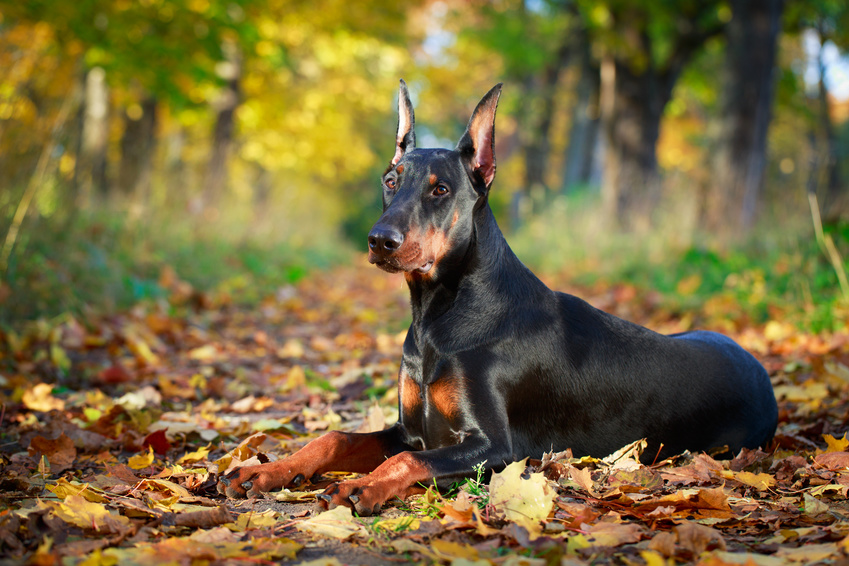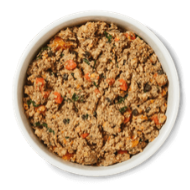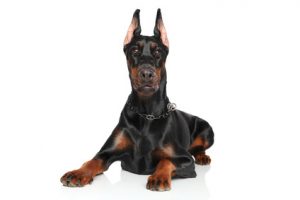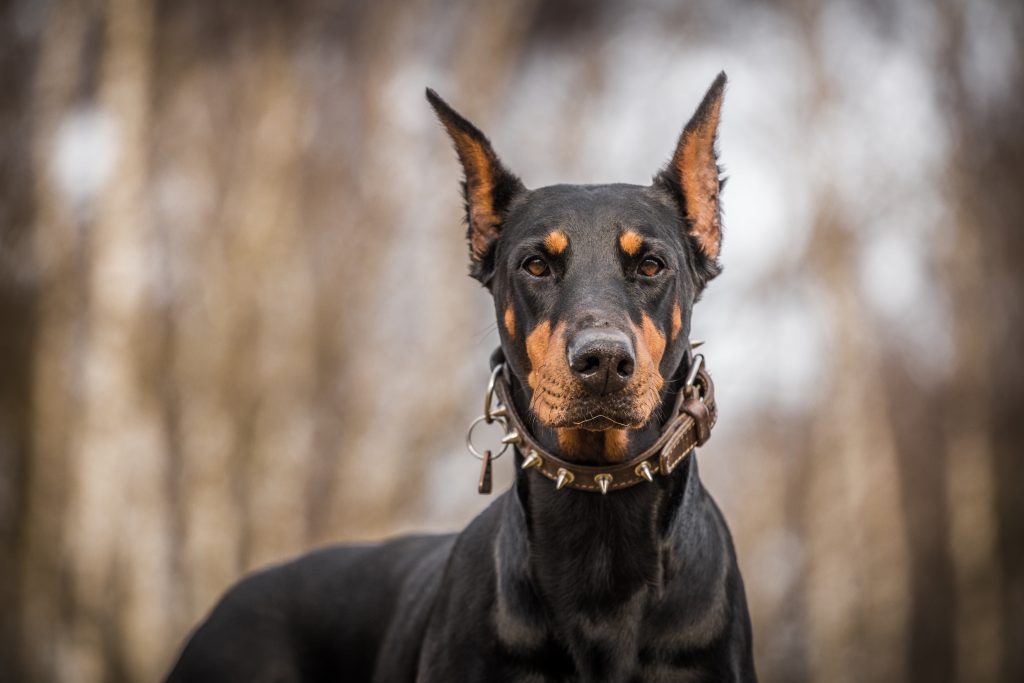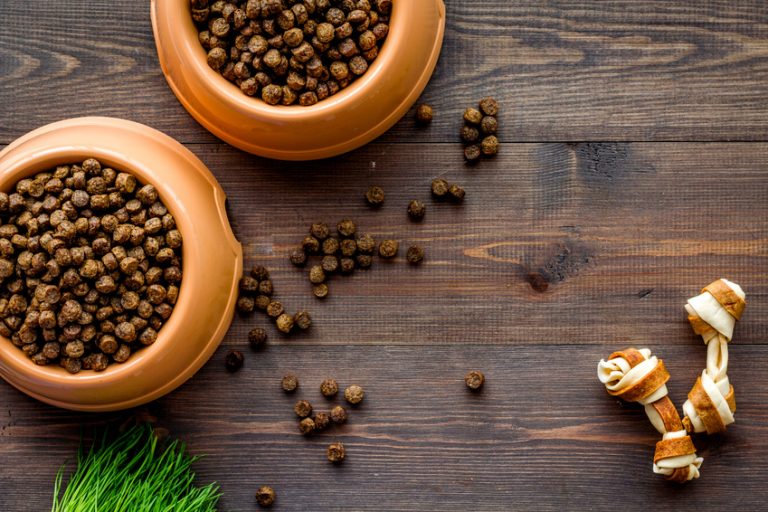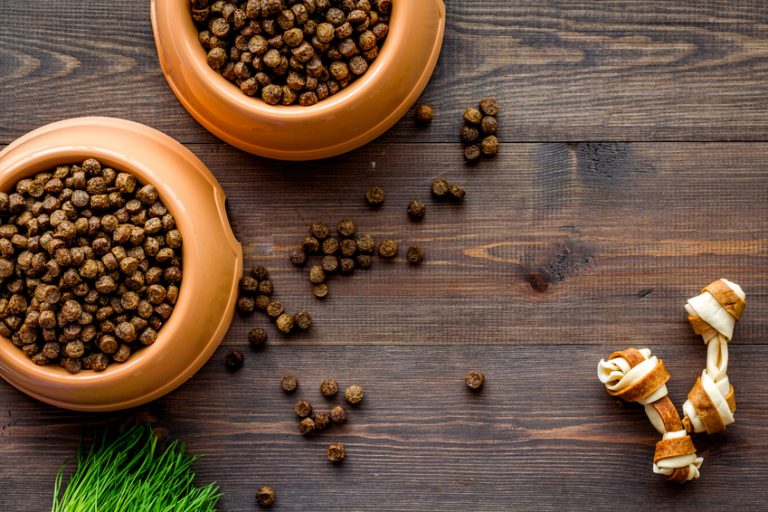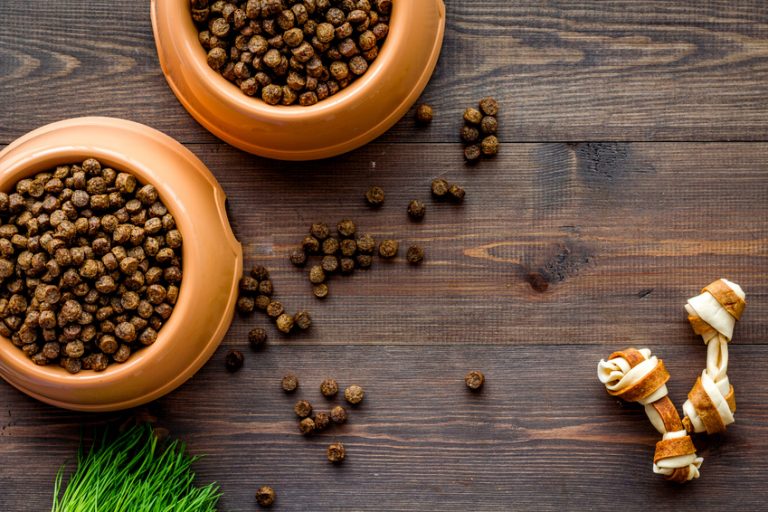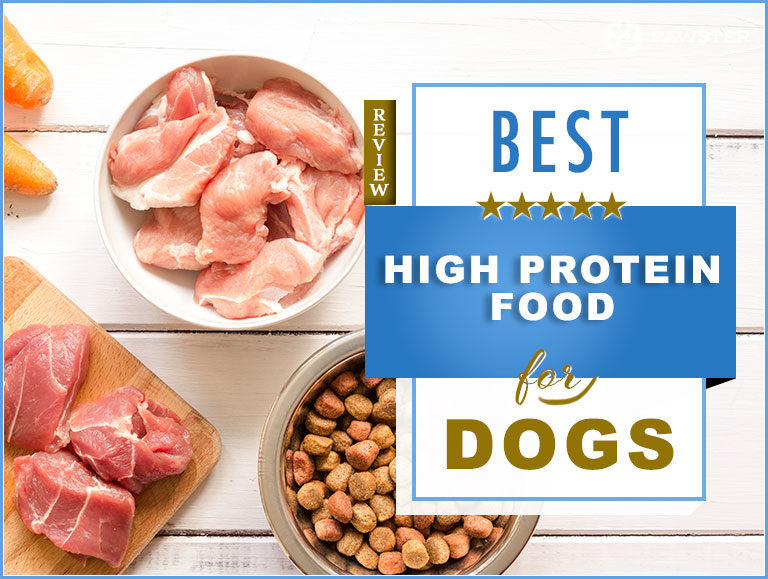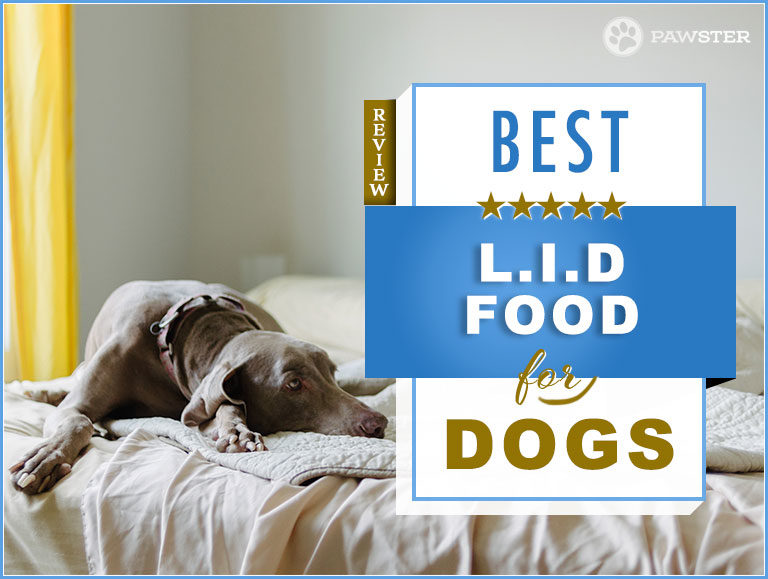Best Dog Foods for Audult and Puppy Doberman Pinscher
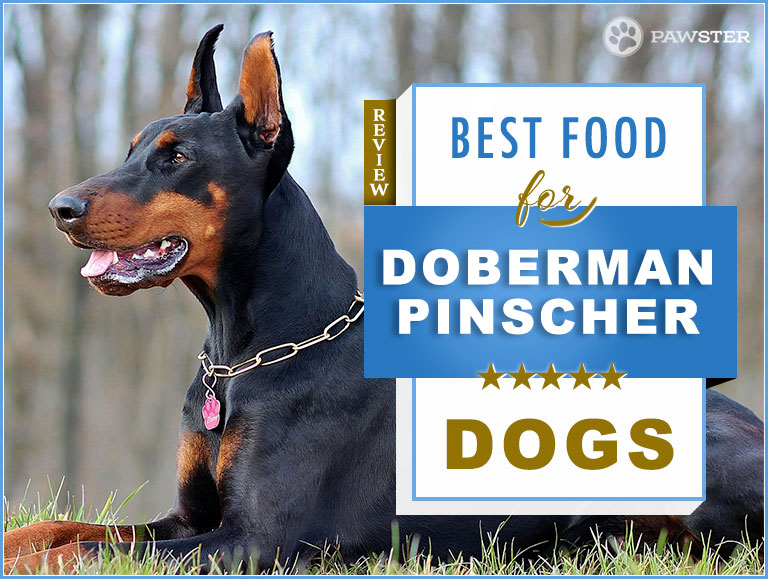
Contents of Article
The iconic look of the Doberman Pinscher shows a dog that is sleek, elegant, athletic, and powerful.
In the U.S. Dobermans traditionally have cropped ears and docked tails. Dobermans are exceptionally intelligent and loyal. These traits usually make them very easy to train. They are working dogs and have historically been kept as guard dogs, military dogs, and police dogs. They are fearless but modern breeders have worked to make sure they are not aggressive. Doberman Pinschers today respect and protect their owners. They are normally sociable dogs but they are not always friendly toward strangers. There is some evidence to suggest that American Dobermans have a more moderate, good-natured temperament than dogs bred elsewhere since breeders in the U.S. have worked on these traits for several decades. Good early socialization and training is recommended.
Dobermans are medium-large dogs. They can weigh up to 100 pounds. Most people think of Doberman Pinschers as black with rust points but they can actually be several different colors: black and rust; blue and rust; fawn (isabella) and rust; and red and rust.
Here is the 8 Best Foods To Feed an Adult and Puppy Dalmatian in 2024
What is the Best Dog Food for Doberman Pinschers?
- American Journey Salmon & Sweet Potato Recipe Grain-Free Dry
- Ollie Healthy Turkey Feast Fresh Dog Food
- Taste of the Wild High Prairie Grain-Free Dry
- Now Fresh Grain Free Large Breed Adult Recipe
- Wellness Large Breed Complete Health Adult Deboned Chicken & Brown Rice Recipe
- CANIDAE Life Stages Chicken, Duck & Lentils Formula Large Breed Puppy Canned Dog Food
- Holistic Select Large & Giant Breed Puppy Health
Special Dietary and Nutritional Considerations
Dobermans do have some health issues but most of them are not affected by diet. Some Doberman Pinschers can have problems with arthritis or hip dysplasia, as do many large breeds. It’s a good idea to watch your Doberman’s weight throughout his life. Being overweight or obese puts added stress on a dog’s bones and joints. This means that it can worsen any tendency toward hip dysplasia or arthritis.
Bloat also sometimes occurs in Doberman Pinschers. While this is not completely linked to dog food, the way you feed your dog is believed to play a role in its occurrence. For dogs that may be susceptible to bloat it’s recommended that you feed several small meals per day instead of one or two large meals. Using a slow-feed dog bowl can encourage dogs to eat more slowly so they don’t gulp in large amounts of air when they eat. Some of the other information about bloat in dogs has been contradictory such as whether to use raised feed bowls or not. We suggest that you talk to your dog’s breeder for recommendations.
Dog food labels have recommended feeding amounts on their labels but these amounts are generalized for all dogs. You can make more exact calculations for your Doberman by using some of these charts and tables. Large dogs such as Doberman Pinschers usually need about 20 calories per pound/per day but there are some other factors that will influence how much your dog needs. Your dog’s age, activity level, and whether he’s neutered, will all affect the amount of calories he needs. Spayed/neutered dogs usually need fewer calories because the lack of sexual hormones means these dogs have a slower metabolism. If your Dobe is very active, however, he will need more calories. For example, if he’s training for agility, tracking, or doing search and rescue work, he could need lots more calories than average.
A typical Doberman Pinscher weighing 90 pounds, living as a pet, will need about 2038 calories per day. If the same dog is training for agility or doing other work, he might need 3397 calories per day, or more. You have to judge how many calories your dog needs based on the work he’s doing, his physical condition, and whether he’s gaining or losing weight.
Many people like to feed their Doberman Pinscher a large breed dog food. These foods have slightly fewer calories per ounce than other dog foods to help dogs stay slim. They may also contain added glucosamine and chondroitin to help with possible joint problems that may affect large breeds.
Like other puppies, you should expect Doberman puppies to grow quickly for the first several months of life. After that their growth should start to slow down. Since Dobermans are a large breed, you may want to feed a large breed puppy food to encourage slow growth. Rapid growth at a young age can put too much stress on their young bones, especially if a puppy is carrying a lot of weight. Large breed puppy foods typically have fewer calories per ounce than other puppy foods to help puppies stay slim. They may also have reduced calcium and phosphorus levels. Obviously, if you let your Doberman puppy stuff himself on any food, even large breed puppy food, he can become overweight, so watch how much you are feeding.
If you have questions about your puppy’s weight and condition, check with your puppy’s breeder or your veterinarian.
Like all dogs, Doberman Pinschers will do well eating a dog food that is made of good quality ingredients.
Best Doberman Pinscher Dog Food 2024
Most good quality dog foods today are formulated to be suitable for all dogs. You can look for foods that are AAFCO-approved for “All life stages.” These foods would be a good place to start when looking for foods for your Doberman Pinscher. You can feed them to puppies, adults, and senior dogs.
Or you can look for foods that are specially formulated for large breed dogs and large breed puppies. These foods are often recommended for Doberman Pinschers.
Here are some good foods that we like for adult Doberman Pinschers:
American Journey Salmon & Sweet Potato Recipe Grain-Free Dry
Healthy Ingredients : Deboned Salmon, Chicken Meal, Turkey Meal, Peas, Sweet Potatoes
Key Features :
- Complex carbs for energy
- Omega fatty acids for skin and coat
- Protein packed
- No grains
American Journey Grain-Free Dry Dog Food
American Journey Salmon & Sweet Potato Recipe Grain-Free Dry Dog Food is great for dobermans who have specific dietary needs. It doesn’t have corn, wheat, or soy. It has a lot of protein and complex carbs for energy.
If your doberman pinscher has specific dietary needs you need to keep an eye on, American Journey recipes might be a great fit. American Journey pays close attention to keeping out ingredients like wheat, soy, and corn, which can impact your dog’s stomach if they’re sensitive to them.
They also include blueberries, sweet potatoes, carrots, and dried kelp to help boost your pet’s immune system. Sweet potatoes and chickpeas help keep your dog’s energy levels high. Deboned salmon forms the core protein, while flaxseed and salmon oil both bring in Omega-3 and Omega-6 acids.
American Journey recipes provide plenty of consideration for dogs with strict dietary requirements and picky eaters.
Ollie Healthy Turkey Feast Fresh Dog Food
Healthy Ingredients : Turkey breast, turkey liver, kale, carrots, lentils
Key Features :
- Slow-cooked
- Subscription service
- Human-grade
- Fresh foods
Ollie Healthy Turkey Feast Fresh Dog Food
Ollie Healthy Turkey Feast Fresh Dog Food is a fresh, human-grade option delivered right to your doorstep through a subscription service. The food is made in small batches and slow cooked to preserve nutritional integrity.
Ollie is a great option if you are in the market for a super premium, fresh dog food. Just like fresh food diets are gaining popularity with humans, they are becoming popular with pets. Ollie’s ingredients are all human-grade and slow cooked to preserve the nutritional integrity. Ollie does not use any artificial flavors or fillers in any of their recipes, so you can be sure that your dog is getting whole, fresh ingredients. When you sign up for Ollie, you will fill out a profile about your dog to help them create a customized recipe and delivery schedule that will suit your needs. The food is delivered to your doorstep and stored in your fridge or freezer, ready to serve when your pet needs it. Although Ollie is more expensive than other dog foods, there are a lot of added benefits that make a fresh food diet something to consider!
Taste of the Wild High Prairie Grain-Free Dry
Healthy Ingredients : Buffalo, Lamb Meal, Chicken Meal, Sweet Potatoes, Peas
Key Features :
- Complex carbs for energy
- Grain free
- Buffalo as protein source
- No fillers
Taste of the Wild High Prairie Grain-Free Dry Dog Food
Taste of the Wild High Prairie Grain-Free Dry Dog Food is a popular choice for pet owners. It has buffalo as the protein source and complex carbs for highly-digestible energy sources.
One of the most popular foods we recommend to pet owners, Taste of the Wild is sure to be a hit with both you and your pet. With buffalo as the source of protein, dogs find this recipe to be delicious and appealing. Additionally, peas and sweet potatoes provide your dog with highly-digestible energy to last all day and real fruits and vegetables provide antioxidant support. Taste of the Wild is a great option for dogs with food sensitivities because it is made with no grain, corn, wheat, filler, artificial flavors, colors or preservatives. Essential minerals are chelated with amino acids in this recipe, to optimize their absorption and ensure maximum benefit, for complete and balanced nutrition.
Now Fresh Grain Free Large Breed Adult Recipe
Healthy Ingredients : De-Boned Turkey, Whole Dried Egg, Potatoes, Peas, Potato Flour
Key Features :
- Supports healthy joints
- Supports heart health
- No grain or gluten
- Helps burn fat and turn it to muscle
Now Fresh Grain Free Large Breed Adult Recipe
Now Fresh Grain Free Large Breed Adult Recipe is grain, gluten, corn, wheat, and soy free. It doesn’t use any meat by-products or artificial preservatives. It supports healthy joints and a healthy heart, too.
Now Fresh is made by the Canadian company Petcurean but it’s easy to find in the U.S. online or in many pet food stores. Now Fresh Grain Free Large Breed Adult Recipe features 100 percent fresh duck, salmon, and turkey. It does not use any grain, gluten, corn, wheat, or soy. It doesn’t have any beef if that is a problem for your dog. And it uses no rendered meats, by-products, or artificial preservatives. This large breed formula is very popular for dogs like the Doberman Pinscher. It includes New Zealand green mussles and glucosamine and chondroitin for joint and hip health. It also has added L-Carnitine to help your dog burn fat and turn it into lean muscle. L-Carnitine also supports a healthy heart which is an added benefit for Doberman Pinschers who can have problems with dilated cardiomyopathy. Taurine also supports heart function and good vision. Add in pre- and probiotics and the food has many desirable features for a large breed dog. It has 27 percent crude protein and 13 percent crude fat, making up 363 kcal/cup. This food looks like a good choice for adult Doberman Pinschers.
Wellness Large Breed Complete Health Adult Deboned Chicken & Brown Rice Recipe
Healthy Ingredients : Deboned Chicken, Chicken Meal, Ground Brown Rice, Barley, Peas
Key Features :
- Source of fiber
- Supports healthy joints
- 26% protein
- Supports digestive health
Wellness Large Breed Complete Health Dog Food
Wellness Large Breed Complete Health Adult Deboned Chicken & Brown Rice Recipe has 26% protein. It has glucosamine and chondroitin to support joint health and complex carbs for energy. It is also a great source of fiber.
Wellness Large Breed Complete Health Adult is made specifically for large breed dogs like the Doberman Pinscher. It has 26 percent crude protein and 12 percent crude fat. It has 340 kcal/cup. The formula includes glucosamine and chondroitin to address joint aches and pains. It also has probiotics and fiber for digestive health; vitamins and minerals to keep your dog’s immune system healthy; and omega fatty acids for a healthy coat and skin. The first five ingredients are: deboned chicken, chicken meal, ground brown rice, barley, and peas. This formula does include oats/oatmeal, ground rice, and barley but these grains don’t usually cause problems for dogs, even if they have food sensitivities to other grains such as corn or wheat. Oatmeal and barley are considered good sources of dietary fiber for dogs. We think Wellness Large Breed Complete Health is a food you should consider for your Doberman.
What is the Best Food for Doberman Pinscher Puppies?
As with other puppies, especially those from large breeds, Doberman Pinscher puppies should be encouraged to grow slowly and stay slim. A good puppy food should provide enough calories and energy for your puppy without over-doing it.
Here are some puppy foods we like for Doberman Pinscher puppies:
CANIDAE Life Stages Chicken, Duck & Lentils Formula Large Breed Puppy Canned Dog Food
Healthy Ingredients : Chicken, Duck Broth, Duck, Dried Egg Whites, Brown Rice
Key Features :
- No corn, wheat, or soy
- Made for large breed dogs
- Includes probiotics
- Antioxidant support for immune system
CANIDAE Life Stages Large Breed Puppy Canned Dog Food
CANIDAE Life Stages Chicken, Duck & Lentils Formula Large Breed Puppy Canned Dog Food is a canned choice that is made for puppies who are going to end up more than 50 pounds. It has probiotics and antioxidants, and does not include corn, wheat, or soy.
Canidae has been a respected dog food company for many years, especially among serious dog breeders and people who compete with their dogs in many dog sports. Many breeders recommend Canidae foods. Canidae All Life Stages Large Breed Puppy food is formulated for puppies that will mature weighing more than 50 pounds. The first five ingredients in this food are: chicken, duck broth, duck, dried egg whites, and brown rice. The food has no corn, no wheat, no soy. It has probiotics, antioxidants, and omega-6 and omega-3 fatty acids. It has 9.5 percent crude protein and 7.5 percent crude fat, with 429 kcal/13 oz can. Canidae also makes dry food for large breeds and they have a new kibble formula for large breed adult dogs. This would be a good puppy food for any owner trying to encourage slow growth in their Doberman puppy.
Holistic Select Large & Giant Breed Puppy Health
Healthy Ingredients : Lamb Meal, Ground Brown Rice, Ground White Rice, Chicken Meal, Dried Beet Pulp
Key Features :
- 23% protein
- DHA to support brain and eye health
- Healthy fiber to support digestion
- Active probiotics
Holistic Select Large & Giant Breed Puppy Health
Holistic Select Large & Giant Breed Puppy Health includes active probiotics and healthy fiber. It has DHA to support brain and eye health. It also has 23% protein.
Holistic Select Large & Giant Breed Puppy Health is available in a lamb meal and oatmeal recipe. The formula includes active probiotics, healthy fiber, and digestive enzymes to help your Doberman puppy’s digestive system. The food includes meat protein in the form of lamb, chicken, and fish meals. DHA supports healthy brain and eye development. The first five ingredients in the food are: lamb meal, ground brown rice, ground white rice, chicken meal, and dried beet pulp. This formula has 23 percent crude protein and 12 percent crude fat with 375 kcal/cup. Holistic Select has a number of good kibble and canned foods including a grain free puppy food with higher protein and fat percentages, if you don’t like this formula.
General Nutritional Recommendations
All dogs, including Doberman Pinschers, need dietary basics such as protein, fat, and carbohydrates. According to the National Academies’ National Research Council (NRC) which studies animal nutrition, protein, fat, and carbs all provide your dog with good sources of energy. Protein also supports your dog’s immune system. It helps repair cells so wounds can heal. It helps build lean muscle. And it helps your dog have healthy skin and coat. Protein is good for all dogs, of every age, whether they are growing puppies or seniors. The only exception would be is your dog has a health problem that might require less protein in his diet such as severe kidney disease. Even if your dog has early stage kidney disease, the latest research indicates that dogs do not need to reduce their protein intake.
Canine nutritionists today generally recommend that dogs have lots of animal protein in their diet. Dogs can digest plant protein but they aren’t able to digest these ingredients as easily as animal proteins. Plant proteins are commonly found in dog foods today in the form of peas and lentils, even in many good quality foods. If you are feeding a food that has a lot of plant protein you will probably have to feed your dog more of these proteins than if your dog were eating a food that used animal proteins. This is because plant proteins don’t have as much bioavailability to dogs as animal proteins. Your dog might have to eat two or three different kinds of plant proteins (peas, chickpeas, lentils, quinoa, etc.) to get all of the amino acids found in one meat protein.
Lots of dog foods today use plant proteins. That includes many of the well-known, costly foods. Even if they tout having lots of meat protein they often include a lot of plant protein. Peas and lentils are less expensive ingredients for pet food companies than most meat proteins. In some ways they have become the new filler ingredients, replacing corn and wheat. Peas and lentils do have higher protein percentages than corn and wheat. They have some other advantages over corn and wheat. But they can also have some drawbacks. Some dogs have difficulty digesting foods that have lots of plant protein. We are also beginning to see some dogs with food allergies/sensitivities to peas. This is not unexpected since peas are such a common dog food ingredient now.
Grain free dog foods today often rely on peas and lentils. These foods can have high protein percentages but it’s important to know how much of the protein in the food comes from animal sources and how much comes from plant sources of protein. If most of the protein in the food comes from plant sources, your dog may not be able to utilize it very effectively, even if the protein percentage on the label is quite high. In some cases you could be better off feeding your dog a food that contains small amounts of grain if the food has more animal protein.
It’s not necessary to completely avoid foods that use plant sources of protein as long as the food has plenty of animal protein. Look for foods that have several good sources of animal protein as the first ingredients such as whole meat proteins and named meat meals. Peas and lentils may come later in the ingredient list. Keep in mind that whole meats do contain large amounts of water. This means that after they are cooked and the water is removed, these meat proteins would be listed much lower in the ingredient list. So, if the first ingredient in a pet food is whole chicken and the next three ingredients are peas, lentils, and chickpeas, chances are that your dog is eating mostly plant protein. Foods that list a whole meat followed by a named meat meal are a better choice.
AAFCO (the Association of American Feed Control Officials) recommends that adult dogs such as Doberman Pinschers have at least 18 percent protein in their diet. Growing puppies need at least 22 percent protein in their diet. Most dog foods today have higher protein percentages than these recommendations. You may see limited ingredient diet (LID) foods or hypoallergenic foods that have lower protein percentages. They may have to use plant proteins or some unusual meat proteins to avoid common allergens for dogs. In general, most experts today recommend that healthy adult dogs eat a diet that has more protein, moderate fat, and low carbohydrates. If your Dobe has a health problem of any kind, we recommend that you consult with your veterinarian for advice about what to feed him. A canine nutritionist may also be able to advise you.
As with other dogs, good sources of animal protein for your Doberman include meat, poultry, fish, and eggs. These sources of animal protein will provide your dog with all of the essential amino acids he needs for good health.
Fat is also important for your Doberman’s health. We often think of fat as something to avoid in human diets but good quality fat is a healthy part of your dog’s diet. Along with providing energy, it’s also a source of fatty acids such as omega-3 and omega-6. These essential fatty acids help your dog have a healthy skin and coat, among other things. Essential fatty acids (EFA) also help your dog absorb vitamins A, D, E, and K.
Once again, animal sources of fat are usually better for your dog than fats from plants. This is because your dog is able to utilize them more easily. Some good sources of fat for your dog include chicken fat, fish, and salmon oil.
Flaxseed oil is also a source of omega-3 fatty acid and you will find many dog food companies using it today in their foods. However, dogs are not able to use this source of omega-3 the way they can use omega-3 from fish/animal sources. Omega-3 from fish oil or salmon oil contain EPA and DHA. These are the active forms of omega-3. Flaxseed oil contains alpha linolenic acid (ALA). ALA is an inactive precursor to EPA and DHA. Dogs have problems converting ALA to DHA and EPA. Consequently, flaxseed oil is not a very good source of omega-3 for dogs.
According to AAFCO, adult dogs need a minimum of 5 percent fat in their diets. Puppies should have a minimum of 8 percent fat. Puppies grow very fast in the first year, especially during their first few months. They are burning lots of calories. As their growth slows, their need for calories starts to diminish until they are eating amounts suitable for an adult dog by the time they are about a year old.
Most dog and puppy foods today have fat percentages that exceed the AAFCO recommendations. Weight loss/control dog foods can have low fat percentages and low calories but nearly all other foods will have moderate to high fat levels.
Most healthy pet dogs who are not engaged in hard exercise should eat a dog food that has a fat percentage about half of the food’s protein percentage. For instance, if your dog’s food has a protein percentage of 28 percent, then a fat percentage of about 14 percent would be appropriate. Dog foods with a fat percentage between 12 and 16 percent (dry matter basis) are usually considered to be moderate in fat by today’s dog food standards. Foods with a protein percentage between about 24 and 32 percent (DMB) are generally considered acceptable for most healthy adult dogs. It’s not hard to find lots of good quality dog foods that fall in these ranges.
You have probably seen comments or heard people say that dogs don’t “need” carbohydrates. In truth, carbohydrates are an important part of your dog’s diet. In some cases you probably think of carbohydrates by other names. Fiber can come from carbs. Prebiotics can come from carbs. Plus, carbohydrates are one of the main sources of energy for your dog. Most ingredients in a dog food are not 100 percent protein or 100 percent carbohydrates or anything else. Foods are made up of all kinds of nutrients. The chickpeas in your dog’s food are almost 70 percent carbohydrates. The sweet potatoes are more than 90 percent carbs. Even if you are trying to avoid some obvious carbohydrates, your dog is probably getting carbs in his diet. Carbohydrates don’t have to come from corn or wheat. They come from all kinds of ingredients.
Many dog owners today dislike the idea of carbs in dog foods because in the past so many companies have over-used ingredients such as corn, wheat, and some poor quality poor ingredients as fillers. Some of these ingredients, such as corn, have also been used as plant sources of protein, making people even more averse to them. However, this doesn’t mean that all carbohydrates should be shunned. Rice, corn, peas, lentils, sweet potatoes, and potatoes all contain lots of complex carbs. Used in small amounts – and not as filler ingredients – these ingredients can be useful in dog foods. They don’t have to be replacements for meat. Fruits and vegetables – also sources of carbohydrates – can also be healthy additions to dog foods. The carbs chicory and beet pulp are also useful in dog foods as prebiotics.
Insoluble carbohydrates can help your dog’s digestion as a source of fiber. Instead of breaking down in your dog’s gastrointestinal tract, this fiber absorbs water, helping food material move along. Too much fiber can result flatulence and loose stools but many dog foods include some of these insoluble carbs in their recipes today. Most kibbles today have between 3.3 and 6 percent (DMB) fiber. You may see larger amounts of fiber in weight control dog foods or in foods that are lower in quality so it’s worth reading the label to know how much fiber is in the food.
The total amount of carbohydrates in a dog food today can range from about 30 percent to 50 percent. A few companies have very low carbs but it can be hard to find low carb dog foods. Pet food manufacturers are not required to provide information about carbohydrates in their foods but you can check dog food reviews such as those on Pawster to find this information or try to figure it yourself. You can also contact the company for information about carbs but not all companies will provide this information.
Most pet food experts suggest that good dog foods should have no more than 20 to 30 percent carbohydrates. It’s not always easy to find foods with a carb percentage this low. We recommend looking for foods with lower carbs but don’t be surprised if you discover that many of the foods you like – even some of the best quality foods – have carbohydrate percentages that are higher than these figures. Kibbles do need a certain amount of carbohydrates (starch) to make their dough; and so the dough will go through the machinery. However, most kibbles have more carbs than you would probably expect.
Like other dogs, Dobermans need vitamins and minerals in their diet. You may think that all of your dog’s vitamins and minerals come from the food ingredients in his food but most dog foods are cooked at such high temperatures (and heated multiple times) that many of the nutrients are lost during cooking. Dog food companies add vitamins and minerals to the food to make up for the nutrients that are lost. Many companies buy their vitamins and minerals from countries outside the U.S. such as China, France, Canada, and other countries. Many dog lovers are concerned about ingredients that are sourced from China, including vitamins and minerals. If you are concerned about where a food’s vitamins and minerals come from, you can often find the information on a company’s web site. Check the FAQ section. Or you can contact the company directly. In some cases certain minerals can be hard to obtain so companies may not have many options. But if this issue is important to you, you should contact the company and let them know about your concerns.
Many dog foods today also add digestive enzymes or probiotics to their formulas. You may see these ingredients listed on a label as “fermentation products. Probiotics are added to improve your dog’s digestion.
You should try to avoid dog foods that have artificial flavors, colors, and sweeteners, along with artificial preservatives. Artificial preservatives include: ethoxyquin, butylated hydroxyanisole (BHA), butylated hydroxytoluene (BHT), tert-butyl hydroquinone (TBHQ), and propyl gallate. Vitamin E, Vitamin C, and certain plant extracts such as rosemary oil are often used as natural preservatives. Natural preservatives will not keep a food fresh as long as artificial preservatives but they are considered to be healthier for your dog.
| Doberman Pinscher Food Comparison Table | |||
| Rank | Product | Price | Rating |
| Best Value |
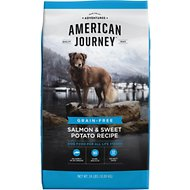 American Journey Salmon & Sweet Potato Recipe Grain-Free Dry |
$1.45/lb |
A+
|
| Human Grade |
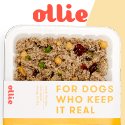 |
Varies |
A+
|
| Most Popular |
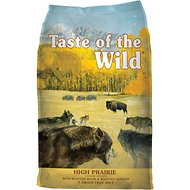 |
$1.55/lb |
A+
|
| #1 |
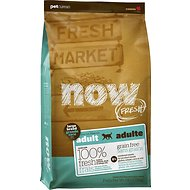 |
$3.16/lb |
A+
|
| #2 |
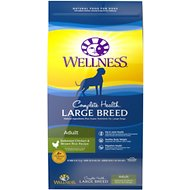 Wellness Large Breed Complete Health Adult Deboned Chicken & Brown Rice Recipe |
$1.98/lb |
A
|
| #3 |
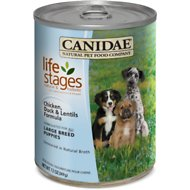 CANIDAE Life Stages Chicken, Duck & Lentils Formula Large Breed Puppy Canned Dog Food |
$2.25/13 oz can |
A+
|
| #4 |
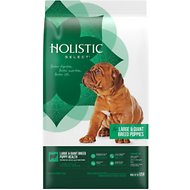 |
$2.00/lb |
A
|
Conclusion
These are only a few suggestions for your Doberman Pinscher. There are lots of good dog and puppy foods today, including foods specially formulated for large breeds. What really matters is finding a food that meets your dog’s nutritional needs. Take the information provided here and use it when selecting a dog food. If you need some help, start with one of the foods recommended here or look at some of the foods we have reviewed on Pawster.

